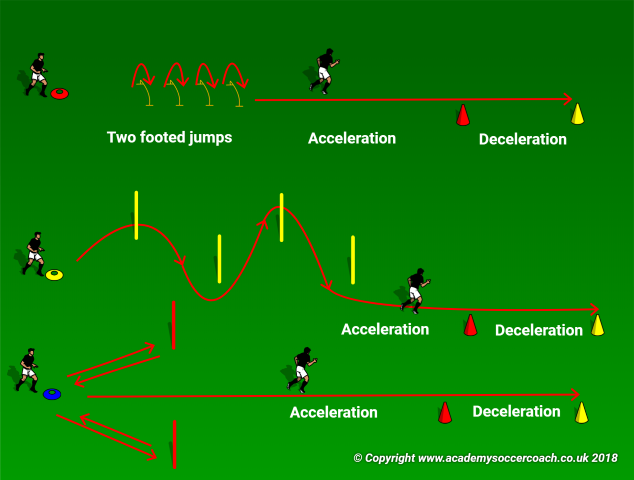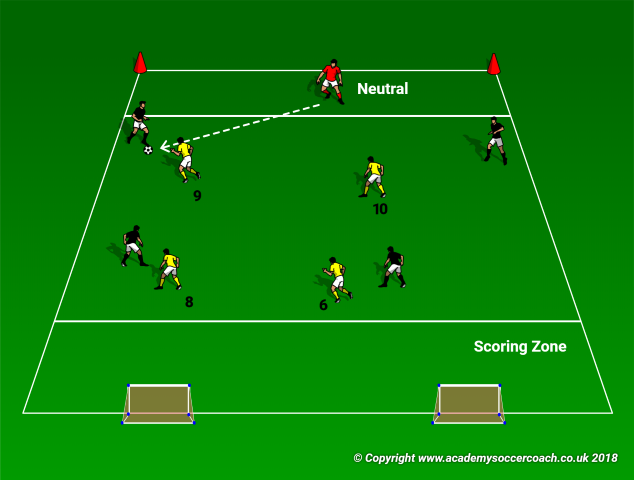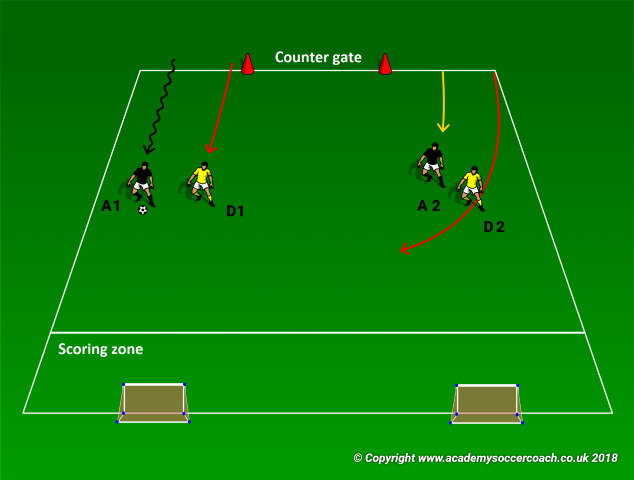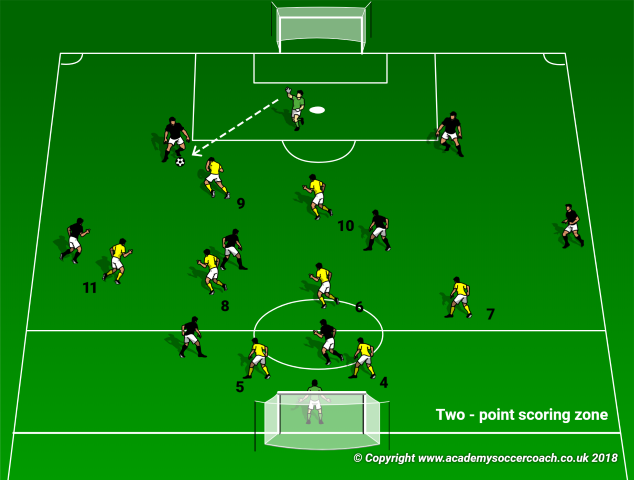By Philip Cauchi
Moment of the game: Opponents in possession.
Theme: Defending from the front.
Age category: Under 17 to senior team level.
Number of players: 18.
Aim: To prevent the opponents from playing penetrative passes.
System of play: 1-4-4-2
Key performance outcomes:
Strikers make play predictable towards the outside.
Apply pressing on closed balls.
Drop on open balls.
Compactness in midfield.
Guide the spaces between the lines.
Outnumber opponents around the ball.
Equipment:
Markers x 10.
Hurdles x 4.
Poles x 6 (4 yellow and 2 red).
Balls x 10.
Bibs x 7.
Mini goals x 2.
Duration: 75 minutes.
Description: In this session we work towards team communication in the phase of non-possession when the opponents are constructing play from the back. Our main aim is not to let them play into central areas where they can commit the most danger. It is thus of extreme importance that our two strikers work well together to make play predictable towards the outside. We can consider the flank to be another defender in our favour as there is less space and thus less options for the opponents to play. Our lateral midfielders must be quick to recognise the triggers when the opponents are going to play wide. This enables them to quickly apply pressure on the opponent receiving the ball thus preventing him from turning to play forward. The central midfield unit must remain compact and ready to intercept any passes played through the middle. The opposite side lateral midfielder moves towards the inside to make the midfield more compact. The central defenders communicate with the midfield unit to mark or track any opponents roaming between the lines.
Warm-up: 2v2 plus two target neutrals.
Aim: To prevent the opponents from playing penetrating passes and win possession to counter.
Organisation: Play takes place inside a marked area measuring 15 yards by 10 yards. We have three teams of two players each with one of them acting as neutrals.
Description: Start the session with a ten minute neuro-muscular activation exercise routine such as shuffling, high knee running, etc to get the nervous system switched on and the blood pumped into the muscles that will be most active during the training session. The activation part is followed with a 2v2+2 where the aim of both teams is to pass the ball to the opposite target player (red) who is allowed to move along the designated horizontal line to receive the ball. If this is accomplished, teams keep possession of the ball and aim to score by passing to the target player on the opposite side. The other neutral player can be used by the team in possession to secure the ball. However, this player is not allowed to pass the ball directly to the target player. Rotate players’ roles every one minute and intersperse these bouts of activities with dynamic stretching and mobility exercises.
Duration: 10 minutes – five series of one minute each interspersed with one minute dynamic flexibility and mobility exercises.
Targeted key performance outcomes:
Compactness.
Coordinated movements between the two defenders.
Timing to win the ball.

Strength Circuit.
Aim: To develop coordinated and explosive movements that stimulate the neuro-muscular system in a way which is similar to the demands of soccer.
Organisation: Three stations. In the first station we have four mini set 80cm apart with an acceleration zone of fifteen meters and a deceleration zone of four meters. In the second station, there are poles set two meters apart and diagonally from each other with an acceleration zone of ten meters and a deceleration zone of two meters. In the third station there are two poles set five meters apart and three meters diagonally from the start. This is followed with an acceleration zone of twenty meters and a deceleration of five meters.
Description: First station – Players perform four two-footed jumps followed by an accelerated run up to 80% of maximal for fifteen meters and decelerating in four meters. Second station – Players slalom run around poles, then accelerate up to 70% of maximal for ten meters and decelerate in two meters. Third station – Players run to the pole at their right, then back to start and then repeat to their left pole and back prior to accelerating up to 90% for twenty meters and decelerating in five meters.
Duration: 10 minutes – perform for one minute at each station, rest for another minute prior to moving to the next station. Repeat twice.

Game situation: 4v4+1 defend the two target goals plus counter.
Aim: To coordinate the movements of the attackers to prevent the opponents from building up play through the middle.
Organisation: The area of play measures 35 yards by 25 yards. A scoring zone and a neutral zone are marked at opposite sides of the grid. A neutral player is positioned in the neutral zone, while two mini goals are positioned on the endline of the scoring zone.
Description: The attacking team (blacks) aims to score in the two mini goals from inside the scoring zone. The defending team (yellows) aims to win the ball and counter by stopping the ball behind the endline in the neutral zone – the line between the two red cones. The neutral player plays with the team in possession of the ball but must remain inside the neutral zone. Restarts always take place by the attacking team from inside the neutral zone.
Duration: 16 minutes – four series of three minutes each interspersed with ninety seconds of rest.
Targeted key performance outcomes:
Strikers to remain compact and force play towards the sideline.
Maintain a compact distance between the midfielders and strikers.
Create a strong zone to outnumber opponents around the ball.
Midfielders to stay compact and cover the middle zone.
Stance to mark the opponent inside the area.
Timing to attack and win the ball.

Practice: Recover at speed to defend.
Aim: To recover quickly and establish balance in the defensive structure of the team in a 2v2 situation.
Organisation: The area of play measures 25 yards by 15 yards. A scoring zone is marked at the end of the grid. We have two attackers and two defenders all starting from the same endline. First attacker (A1) starts two meters away from the first defender (D1). The second defender and attacker start on the opposite end of the same line. A counter gate is marked – the line between the two red cones. This counter gate measures five meters in length.
Description: First attacker (A1) dribbles forward while being pressured by the first defender (D1). At the same time the second attacker (A2) and defender (D2) start their run to make it a 2v2. The defenders aim to prevent the attackers from scoring from inside the scoring zone, win the ball and counter on the counter gate. This action is done at speed and defender D2 starts further away from attacker A2 so that D2 has to recover and get ball-side.
Duration: 10 minutes – eight repetitions performed at maximal intensity. Rest between forty seconds and one minute between repetitions.
Targeted key performance outcomes:
Defender D1 applies pressure to push attacker A1 towards the outside.
Defender D2 recovers in position (ball-side) to mark attacker A2.
Cut off passes to A2 and outnumber A1 2v1 on the ball.
Timing of tackles to win the ball without fouling.

Global: Team collective defending.
Aim: Retain compactness and timed pressing actions.
Organisation: Play on a pitch slightly longer than half the size of a regular soccer field. Each team consists of nine players with both teams lined up in a 1-2-4-2 system of play.
Description: Normal soccer rules apply except that if the attacking team (blacks) scores from inside the area between the centre line and the yellow team’s goal line, the goal counts double. If the yellow team wins the ball in front of the centre line and scores, the goal counts double.
Duration: 20 minutes – two series of nine minutes each with two minutes rest in between.
Targeted key performance outcomes:
Team compactness.
Timing and angle of movements by the strikers to make play predictable.
Coverage of the central midfield zone.
Distance between the three main sectors; defence, midfield and attack.
Mark players between the lines.
Intercept passes played into the middle.

Cool down: Core work and static stretching.
Description: The session ends with the players performing various exercises that targets core strength development. Exercises include variations of planks and especially dynamic ones. This will be followed by static stretching exercises with particular emphasis on hamstring, glutes, quadriceps, adductors, abdominals and back muscles.
Duration: 10 minutes.
By Philip Cauchi


